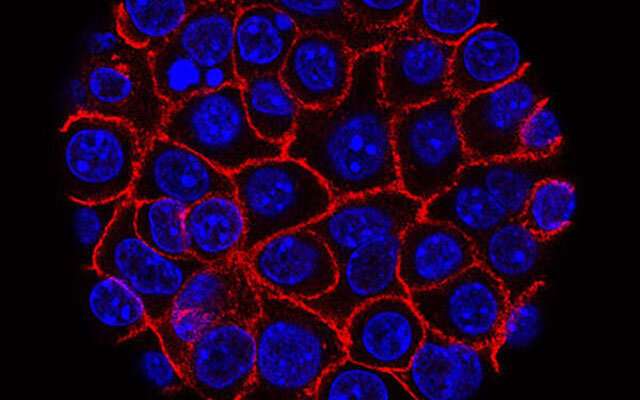Q&A: Pancreatic cancer risk, symptoms and treatment

My mother recently was diagnosed with diabetes, but due to abdominal pain and other issues, her doctor suspects she might have pancreatic cancer. How is pancreatic cancer diagnosed and what are the symptoms to watch for?
ANSWER: I am so sorry to hear about your mother's recent issues. It can be a scary time for everyone when there is uncertainty related to a cancer diagnosis, let alone general health issues.
Although it is not a common form of cancer, pancreatic cancer is a very serious disease and is considered one of the least survivable cancers. This is because it spreads, or metastasizes, quickly before symptoms appear—often resulting in late detection. Approximately 60,000 people are diagnosed with pancreatic cancer annually in the U.S., with the average age of diagnosis at 70. However, the incidence of diagnosis in younger people is steadily increasing.
As with many other cancers, only a small fraction of pancreatic cancer cases have specific, known heritable genetic causes, but there is an increased risk if other immediate family members have been affected. For most people diagnosed with pancreatic cancer, there is no obvious predilection, but there are some known risk factors. Smoking is one of the most common to be strongly associated with pancreatic cancer risk.
There also is an association between pancreatic cancer and diabetes. Diabetes is much more prevalent than pancreatic cancer, and a diabetes diagnosis by itself does not mean someone may have pancreatic cancer. Research is indicating that some patients are presenting with a new diagnosis of diabetes one or two years prior to their pancreatic cancer being detected. This also has been noted in patients with preexisting, well-controlled diabetes that becomes more difficult to manage without any obvious cause.
Common symptoms of pancreatic cancer include loss of appetite or unintended weight loss; fatigue; abdominal pain that can radiate to the back; and diarrhea, with stools that can be greasy, oily and float in the toilet. As people age, constipation tends to be common, so new diarrhea is usually abnormal in older patients.
If a tumor is in the head of the pancreas, patients can present with jaundice, marked by yellowing of the skin and eyes, due to blockage of bile from the liver, which may initially show up as darker, cola-colored urine and lighter, pale-colored stools. If any of these symptoms are present, patients should seek further medical evaluation.
If there is high suspicion of a pancreatic cancer diagnosis, then there are several specific investigations that need to take place. This starts with basic laboratory tests looking at blood counts and electrolytes, kidney and liver function, nutritional labs, and tumor markers, such as CA19-9.
Concurrently, there are necessary imaging and diagnostic procedures performed as well. The most common include cross-sectional imaging typically performed via a CT scan of the chest and abdomen. If there is a mass in the pancreas identified on the scans, then additional procedures to obtain a biopsy or ease any associated bile duct obstruction are performed with an endoscopic ultrasound and endoscopic retrograde cholangiopancreatography.
If a diagnosis of pancreatic cancer is confirmed, then additional studies, such as positron emission tomography (PET) scan, may be useful. Patients are then clinically "staged" according to all these results.
The simplest staging consists of categorizing the cancer as either metastatic, meaning the tumor has spread to other locations, or nonmetastatic, meaning the tumor has not obviously spread. Patients whose cancer is categorized as metastatic are further grouped according to whether the tumor has extended outside of the pancreas to involve any critical blood vessels. Staging is critical because it helps to determine the best course of treatment.
All patients with pancreatic cancer will require chemotherapy. Patients who have a nonmetastatic form of cancer also are candidates for other local treatment options, such as surgery and/or radiation therapy.
We do know that surgery is the only known curative treatment for pancreatic cancer. However, for surgery to be effective, we need to obtain a negative margin, meaning the tumor can be surgically removed without leaving any cancer behind. In patients with more complex tumors that involve blood vessels or have other high-risk features, we often consider giving chemotherapy and radiation prior to surgery.
There have been promising advances in the treatment of pancreatic cancer within the last decade, helping patients live significantly longer than ever before. This primarily is due to more effective combination chemotherapy regimens.
With the introduction of these chemotherapy treatments, we also have seen a dramatic shift in how we define which patients are candidates for surgery. In years past, only about 15% of patients were eligible for surgery, but with advances in chemotherapy, radiation and new surgical techniques, up to 50% of patients now have the possibility of being considered for surgery.
Extensive research shows pancreatic cancer surgery tends to cause fewer complications when done by highly experienced surgeons at a center, like Mayo Clinic, that does many of these operations. Patients should seek second opinions early on to ensure all treatment options are being considered. The outcomes for this cancer are improving, so patients can have much more hope than ever before.
©2022 Mayo Clinic News Network.
Distributed by Tribune Content Agency, LLC.

















